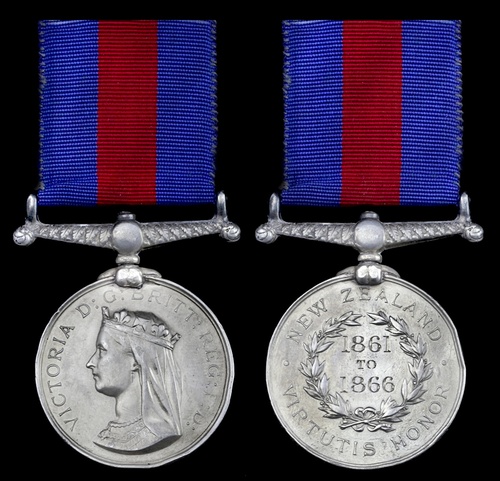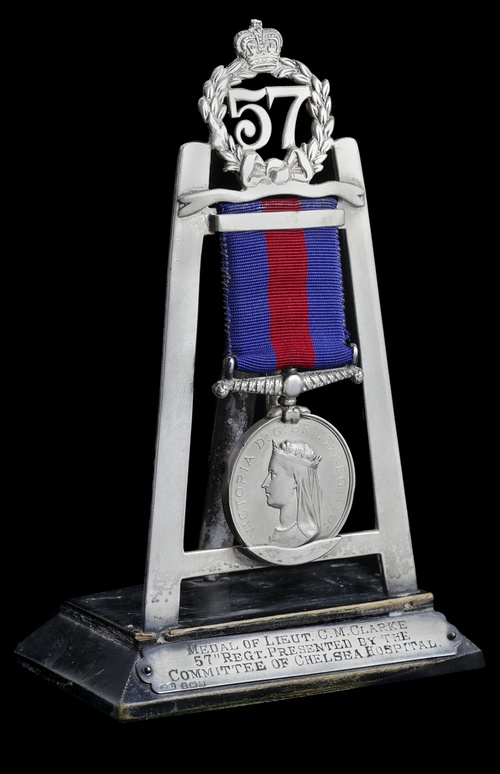Auction: 19002 - Orders, Decorations and Medals
Lot: 22
The New Zealand Medal awarded to General Sir C. M. Clarke, Bt., G.C.B., G.C.V.O., Quartermaster-General to the Forces, Governor of Malta, late 57th Regiment, with whom he served with distinction in New Zealand and South Africa
New Zealand 1854-66, undated reverse, privately engraved '1861 to 1866' (Lieut. C. M. Clarke, 57th Regt.), heavy edge knocks, nearly very fine, housed in a silver mount, from which the Medal is easily removed, surmounted by the regimental number, upon painted wooden plinth, bearing silver plaque with the inscription 'Medal of Lieut. C. M. Clarke 57th Regt. Presented by the Committee of Chelsea Hospital.'
Charles Mansfield Clarke was born on 13 December 1839, educated at Eton College and was commissioned Ensign in the 57th Regiment on 1 March 1856, being promoted Lieutenant 18 November 1859.
New Zealand
The services rendered by Clarke are best summarised by the Daily Southern Cross, October 1865:
'Lieutenant C. M. Clarke served in the war 1860-1 at the Waitara, and has been present in nearly every engagement and operation that has taken place in the province since the commencement of hostilities, under the late Commander of the Forces, Lieutenant-General Sir D. A. Cameron, K.C.B.
At Katikara, on 4 June 1863, at Ahuahu, at Kaitake and at Mataitawa, as also in several minor affairs, Lieutenant Clarke particularly distinguished himself and secured the well-merited approval of the late Lieutenant-General commanding. Under all circumstances Lieutenant Clarke has evinced the ability as well as the zeal and attention which enable an officer successfully perform his duties.'
He served as Adjutant from 1 January 1862-28 February 1866 and is also noted in The Story of the Middlesex Regiment:
'An attack on the Pah at Kaitaki on 25 March 1864 deserves mention because the 57th were on this occasion first associated with the Taranaki Rifles. Parties of the 57th and the local militia attacked on each flank, with the Rifles, guided by Lieutenant Clarke, took them in the rear. The fight was of the usual character, a difficult approach through the bush, a stockade to be clambered over and a charge at the palisade.'
He would leave New Zealand with four 'mentions' (London Gazettes 21 August 1863, 3 January, 14 June & 23 August 1864, refers).
South Africa - command
Promoted Captain, 25 September 1857, Major, 26 July 1876 and Lieutenant-Colonel, 7 May 1878, his Regiment was in Ceylon when ordered to make haste for Natal, in support of the actions against the Zulus. Clarke would command the regiment at Ginginhlovo and then the Flying Column sent to relieve Etshowe. This would be followed by command of 'Clarke's Column', followed by appointment to lead the land forces in the Cape of Good Hope in May 1880-82. He was awarded the Medal & clasp, a C.B. (London Gazettes 28 November 1879, refer) and a brace of 'mentions' (London Gazette 7 May & 10 October 1879, refers).
Higher command - final furlong
Further promotions followed, which culminated in his appointment as Commander-in-Chief, Madras, 1893-98, followed by appointment as Quartermaster-General to the Forces, 1899-1903 (K.C.B. London Gazette 20 May 1895, refers) and his final posting as Governor of Malta, 1903-07 (G.C.V.O. London Gazette 2 June 1903, refers). He had also served as commander of the Sixth Army Corps during the Second Boer War, being awarded a Military Division G.C.B. (London Gazette 19 April 1901, refers). Retired as a full General in 1907, Clarke had succeeded to become the 3rd Baronet of Clarke of Dunham Lodge in 1899 and died on 22 April 1932; sold with copied research.
Subject to 20% VAT on Buyer’s Premium. For more information please view Terms and Conditions for Buyers.
Sold for
£2,100
Starting price
£550







